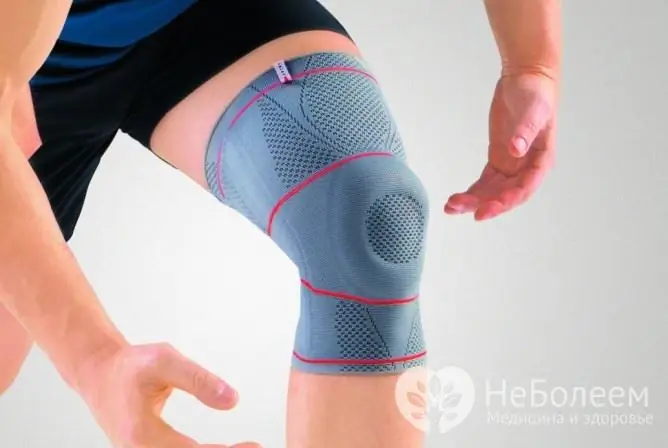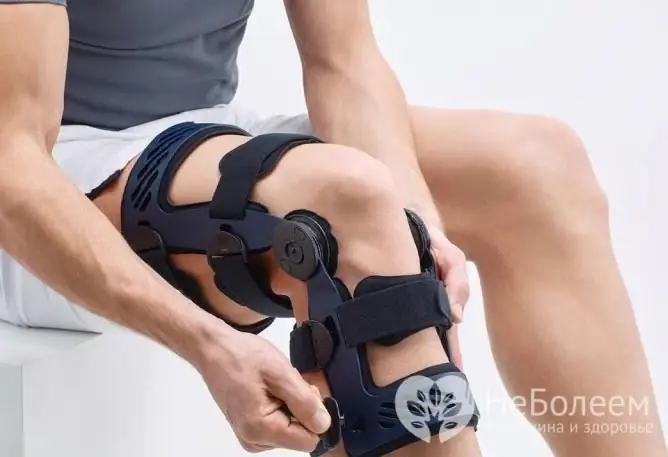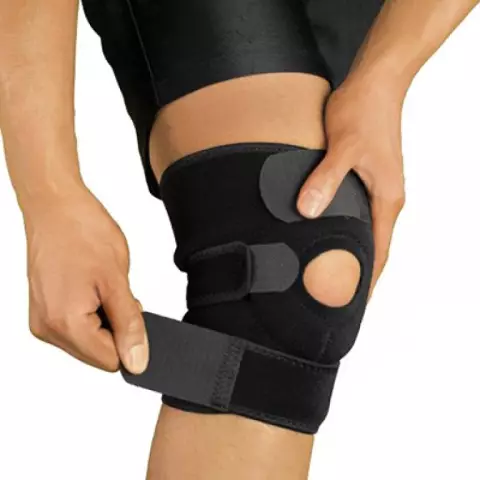- Author Rachel Wainwright [email protected].
- Public 2023-12-15 07:39.
- Last modified 2025-11-02 20:14.
Knee brace: how to choose and wear
To prevent injury to the knee joint, prevent exacerbation of inflammatory diseases, as well as to speed up the recovery process after operations and injuries, experts recommend using a knee orthosis. No joint treatment and rehabilitation program is complete without this elastic product, from the most minor disorders to serious injuries.
To make the orthosis effective, you need to choose the right one, focusing on rigidity and size. Despite the fact that experts call rigid fixators orthosis, many sources use this name for all existing knee fixators, which can be divided into several groups in terms of rigidity.

The doctor will tell you how to choose the correct fixator from the existing varieties, focusing on the intensity of the violations:
- Soft elastic bandages are used for minor injuries - ligament tears, subluxations, dislocations and bruises, as well as when the knee is unstable. Such a bandage is recommended to be worn with increased physical exertion, prolonged walking, hard training for all those who have previously had knee injuries, as well as to prevent exacerbation of arthrosis and arthritis. Special sports braces can have a tighter insert in the joint area for increased compression. This bandage does not limit mobility, but only stabilizes the joint, preventing exacerbation and complications of injuries;
- Semi-rigid orthoses provide partial limitation of lateral movement without affecting flexion / extension function. For firm fixation, the orthosis is reinforced with elastic plastic ribs, rings limiting the kneecap area, plates, ties and Velcro fasteners. Rigid elements can be removed, due to which the fixing force decreases, the amplitude of movement increases, which allows using the orthosis throughout the entire recovery process, up to replacing it with a conventional elastic bandage. Special semi-rigid orthoses - braces are designed for athletes involved in contact sports. They are equipped with special hinge mechanisms that allow you to fix the bent knee at a certain angle (from 10 to 180⁰);
- Rigid orthoses - splints for complete immobilization of the joint after injuries and surgeries on the anterior and posterior ligaments, patella. They are equipped with rigid metal knitting needles, plates, ties and fasteners, which can be 2-3-4 levels.
When a brace is used
When choosing an orthosis, one must understand why a retainer is needed and when it is used:
- with minor injuries, when a person needs to continue training or work, these conditions include - dislocations, subluxations, ligament tears, sprains;
- during the recovery period after injuries and operations, which include ruptures of collateral ligaments, damage to the bone tissue of the calyx, injury to the meniscus and cartilage tissue;
- with joint deformation;
- with hemorrhages in the joint cavity;
- to prevent exacerbation of inflammatory and degenerative diseases of the joints - arthritis arthrosis, as well as during exacerbation;
- to protect the joint during heavy physical exertion, training, especially in strength sports;
- to reduce the load with excess body weight.

Use mode
In order for an orthosis to have the necessary effect, one must know how to wear different types of it. If there are no special prescriptions from a doctor, then the following rules must be observed:
- Soft bandages can be selected and worn without a doctor's prescription. The bandage can be used for any, even minor discomfort in the joint area, especially if the patient has had previous injuries. It is worn only during increased physical activity - during training, moving weights, long walking. If the patient is diagnosed with arthrosis or arthritis, then during the period of remission, the bandage can be worn all day, removing only during rest and sleep;
- The peculiarities of wearing semi-rigid bandages are determined by the doctor. Bandages are usually worn all day, with rest breaks, removed during a night's sleep. The strength of pressure is regulated in accordance with the intensity of the violation and the period of rehabilitation;
- Rigid orthoses are worn only as directed by a doctor, following his recommendations. The bandage is put on almost immediately after the operation and is worn until the moment when the amplitude of flexion-extension must be increased. At this point, the rigid bandage must be changed to a semi-rigid one or its rigidity must be reduced by removing the spokes and plates.
How much to wear semi-rigid and rigid models is determined by the doctor, it is he who must indicate to the patient when to change the model or change the previously prescribed mode. Soft bandages can be worn constantly or only during increased load, determining the duration by their own feelings - heaviness, stiffness, pain in the joint.
It should be remembered that an independent decision to remove a rigid or semi-rigid bandage or to change the mode of wearing it can cause a deterioration in the condition.
Where to buy
To choose and buy a knee brace correctly, you need to focus on the following sizes:
- knee circumference along the center line;
- knee circumference above and below the centerline by 15 cm for a normally elastic band;
- Rigid and semi-rigid orthoses cover a significant area of the thigh and ankle, so the girth should be measured at approximately the level where the orthosis ends.
If the orthosis is selected and put on correctly, then it tightly wraps the leg, adhering to the entire length, and does not pinch soft tissues.
You can buy different models of knee braces quickly and profitably on the website of the Ortocomfort.ua online store, where products from global manufacturers of bandage products are presented.
Found a mistake in the text? Select it and press Ctrl + Enter.






